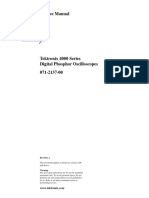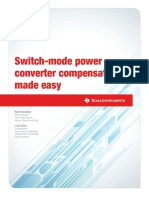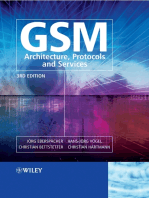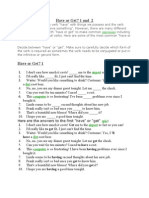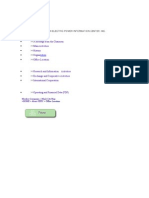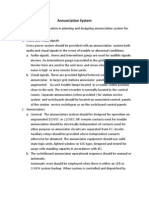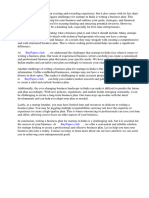Capacitor ESR, Dissipation Factor, Loss Tangent and Q
Capacitor ESR, Dissipation Factor, Loss Tangent and Q
Uploaded by
Irfan UllahCopyright:
Available Formats
Capacitor ESR, Dissipation Factor, Loss Tangent and Q
Capacitor ESR, Dissipation Factor, Loss Tangent and Q
Uploaded by
Irfan UllahOriginal Description:
Original Title
Copyright
Available Formats
Share this document
Did you find this document useful?
Is this content inappropriate?
Copyright:
Available Formats
Capacitor ESR, Dissipation Factor, Loss Tangent and Q
Capacitor ESR, Dissipation Factor, Loss Tangent and Q
Uploaded by
Irfan UllahCopyright:
Available Formats
Capacitor ESR, Dissipation Factor, Loss Tangent and Q
ESR - Equivalent Series Resistance, DF - Dissipation Factor, and Q or Quality factor are three important factors in the specification of any capacitor. They have a marked impact on the performance of the capacitor and can govern the types of application for which the capacitor may be used. As the three parameters are interlinked, ESR, DF and Q will all be addressed on this page. ESR, DF and Q are all aspects of the performance of a capacitor that will affect its performance in areas such as RF operation. However ESR, and DF are also particularly important for capacitors operating in power supplies where a high ESR and dissipation factor, DF will result in large amount of power being dissipated in the capacitor.
Equivalent Series Resistance, ESR
The equivalent series resistance or ESR of a capacitor is particularly important in many applications. One particular area where it is of paramount importance is within power supply design for both switching and linear power supplies. In view of the high levels of current that need to be passed in these applications, the equivalent series resistance, ESR plays a major part in the performance of the circuit as a whole. The ESR of the capacitor is responsible for the energy dissipated as heat and it is directly proportional to the DF. When analysing a circuit fully, a capacitor should be depicted as its equivalent circuit including the ideal capacitor, but also with its series ESR.
The Equivalent Series Resistance, ESR associated with a capacitor Capacitors with high values of ESR will naturally need to dissipate power as heat. For some circuits with only low values of current, this may not be a problem, however in many circuits such as power supply smoothing circuits where current levels are high, the power levels dissipated by the ESR may result in a significant temperature rise. This needs to be within the operational bounds for the capacitor otherwise damage may result, and this needs to be incorporated within the design of the circuit. It is found that when the temperature of a capacitor rises, then generally the ESR increases, although in a non-linear fashion. Increasing frequency also has a similar effect.
Dissipation factor and loss tangent
Although the ESR figure of a capacitor is mentioned more often, dissipation factor and loss tangent are also widely used and closely associated with the capacitor ESR. Although dissipation factor and loss tangent are effectively the same, they take slightly different views which are useful when designing different types of circuit. Normally the dissipation factor is used at lower frequencies, whereas the loss tangent is more applicable for high frequency applications. The dissipation factor can be defined as: the value of the tendency of dielectric materials to absorb some of the energy when an AC signal is applied. The loss tangent is defined as: the tangent of the difference of the phase angle between capacitor voltage and capacitor current with respect to the theoretical 90 degree value anticipated, this difference being caused by the dielectric losses within the capacitor. The value (Greek letter delta) is also known as the loss angle.
Capacitor loss tangent Thus: tan = DF = 1/Q = ESR / XC
Where: = loss angle (Greek letter delta) DF = dissipation factor Q = quality factor ESR = equivalent series resistance Xc = reactance of the capacitor in ohms.
Capacitor Q
It is convenient to define the Q or Quality Factor of a capacitor. It is a fundamental expression of the energy losses in a resonant system. Essentially for a capacitor it is the ratio of the energy stored to that dissipated per cycle. It can further be deduced that the Q can be expressed as the ratio of the capacitive reactance to the ESR at the frequency of interest: Q = Xc / ESR
As Q can be measured quite easily, and it provides repeatable measurements, it is an ideal method for quantifying the loss in low loss components.
You might also like
- MP2825GQKTDocument100 pagesMP2825GQKTryan831022No ratings yet
- Touch Technologies Tutorial Latest VersionDocument315 pagesTouch Technologies Tutorial Latest VersionRoze Galeska100% (1)
- MSO4054 Service ManualDocument78 pagesMSO4054 Service ManualMarina Matic-VujovicNo ratings yet
- Personal Protective Grounding - Training PresentationDocument31 pagesPersonal Protective Grounding - Training PresentationIrfan UllahNo ratings yet
- Analog Dialogue Volume 46, Number 1: Analog Dialogue, #5From EverandAnalog Dialogue Volume 46, Number 1: Analog Dialogue, #5Rating: 5 out of 5 stars5/5 (1)
- Power Solutions GuideDocument60 pagesPower Solutions Guidetheodoiq100% (1)
- Power Supply Tutorial - SMPS PDFDocument3 pagesPower Supply Tutorial - SMPS PDFJavierCastillejosOtharulaNo ratings yet
- Laptop Repair Complete Guide Including Motherboard and Component Level Repair!Document1 pageLaptop Repair Complete Guide Including Motherboard and Component Level Repair!osama OsNo ratings yet
- PCB Design Master Training - CRDocument295 pagesPCB Design Master Training - CRNicu GeeNo ratings yet
- Simulazioni RF With LTSpiceDocument38 pagesSimulazioni RF With LTSpiceCarloNo ratings yet
- Free Batchography: The Art of Batch Files Programming PDF DownloadDocument2 pagesFree Batchography: The Art of Batch Files Programming PDF Downloadgeorge capozziNo ratings yet
- An203 - c8051fxxx Printed Circuit Board Design Notes - Silicon - LabsDocument22 pagesAn203 - c8051fxxx Printed Circuit Board Design Notes - Silicon - LabsEdson PaivaNo ratings yet
- Boost Converter Design TipsDocument45 pagesBoost Converter Design Tipssethhcohen11No ratings yet
- Vertical Deflection ProblemsDocument5 pagesVertical Deflection Problemscarlosquebec248100% (1)
- TheTransistorAmplifier P1Document63 pagesTheTransistorAmplifier P1Marcelo Napoleão BarrosNo ratings yet
- That1510p PDFDocument6 pagesThat1510p PDFJefferson Gutama ValladaresNo ratings yet
- BIOS Disassembly Ninjutsu Uncovered - PrefaceDocument5 pagesBIOS Disassembly Ninjutsu Uncovered - PrefaceRodrigo RochaNo ratings yet
- Single, 2 MHZ Buck-Boost Controller Drives Entire Led Headlight Cluster Meets Cispr 25 Class 5 EmiDocument60 pagesSingle, 2 MHZ Buck-Boost Controller Drives Entire Led Headlight Cluster Meets Cispr 25 Class 5 EmitorinomgNo ratings yet
- (20170913150548) Power MOSFET BookDocument1,422 pages(20170913150548) Power MOSFET BookTarcísio Junior100% (1)
- Electronics Circuits IIDocument50 pagesElectronics Circuits IIjopi60No ratings yet
- 715g3291 PFL3404 SCHDocument1 page715g3291 PFL3404 SCHAlexNo ratings yet
- LVDS SignalsDocument37 pagesLVDS SignalsDariel Hernández CarmonaNo ratings yet
- !!!! Signal Integrity Considerations For High Speed Digital HardwareDocument12 pages!!!! Signal Integrity Considerations For High Speed Digital HardwarePredrag PejicNo ratings yet
- Matching 50Ω to 75Ω: Minimum-Loss PadDocument6 pagesMatching 50Ω to 75Ω: Minimum-Loss Padvaldesc_tolNo ratings yet
- High-Speed Design TechniquesDocument28 pagesHigh-Speed Design TechniquesHemantkumarNo ratings yet
- SMPS Trainer Kit ComputersDocument1 pageSMPS Trainer Kit ComputersChandrakant ChatterjeeNo ratings yet
- JVC Kd-r800 Car RadioDocument151 pagesJVC Kd-r800 Car RadioJuan prietoNo ratings yet
- SmpsrepairebookDocument105 pagesSmpsrepairebookJeank Rivadeneyra100% (2)
- Working With Embedded Multimediacard (Emmc)Document15 pagesWorking With Embedded Multimediacard (Emmc)britto100% (1)
- LCD 16X2 para PicsDocument21 pagesLCD 16X2 para Picsjuarez100% (1)
- Wireless World 1990 01 PDFDocument92 pagesWireless World 1990 01 PDFMilton Nast100% (1)
- Switch-Mode Power Converter Compensation Made Easy: Robert SheehanDocument38 pagesSwitch-Mode Power Converter Compensation Made Easy: Robert Sheehanjimmyboy111100% (2)
- Arduino Programming Part6 Notes LCD 20x4Document10 pagesArduino Programming Part6 Notes LCD 20x4gotik911No ratings yet
- Designing Multi Layer To Balance SI by LeeRitcheyDocument85 pagesDesigning Multi Layer To Balance SI by LeeRitcheyram100% (1)
- Mordax DATA - User Guide - 171002Document29 pagesMordax DATA - User Guide - 171002rustyNo ratings yet
- SCT 4 Platform Design Spec Rev1 4 PDFDocument62 pagesSCT 4 Platform Design Spec Rev1 4 PDFChhoemSovannNo ratings yet
- OEM Technical Guide 15.2 Rev-0.81Document249 pagesOEM Technical Guide 15.2 Rev-0.81Eduardo HuenufilNo ratings yet
- Schematic DiagramDocument12 pagesSchematic Diagramalfredo_izquierdo_12No ratings yet
- DDR3Document36 pagesDDR3itzjishnu100% (1)
- Adiedkhaz Book of Laptop IndexDocument5 pagesAdiedkhaz Book of Laptop Indexavancealdemar56No ratings yet
- YX Technologies Co.,LTD: YX Technology YX Technology YX TechnologyDocument29 pagesYX Technologies Co.,LTD: YX Technology YX Technology YX TechnologyGustavo DestruelNo ratings yet
- Microcontroller HardwareDocument45 pagesMicrocontroller HardwaredineshlathiaNo ratings yet
- UNDERSTANDING VIAS - Mentorpaper - 73085 PDFDocument8 pagesUNDERSTANDING VIAS - Mentorpaper - 73085 PDFDaniel CarrascoNo ratings yet
- JVC TV Power Supply Training GuideDocument110 pagesJVC TV Power Supply Training GuideLuis Granadillo Ojeda100% (1)
- Low Noise Printed Circuit Board DesignDocument9 pagesLow Noise Printed Circuit Board DesignEmaxxSeverusNo ratings yet
- Power Supply Testing - Measuring Power Supply RippleDocument1 pagePower Supply Testing - Measuring Power Supply Rippleluroguita-1No ratings yet
- Ibm E50 LG CH - Ca-120 Cb553hDocument31 pagesIbm E50 LG CH - Ca-120 Cb553hCristina Nistor100% (1)
- I2c TsopDocument7 pagesI2c TsopChayan ShahNo ratings yet
- Bonus: Serial SPI Flash Memory Substitute/Compatible List: ContentsDocument58 pagesBonus: Serial SPI Flash Memory Substitute/Compatible List: ContentsNsb El-kathiri100% (1)
- Gamma Correction - TV Problems and Repair SolutionsDocument4 pagesGamma Correction - TV Problems and Repair SolutionsNsb El-kathiriNo ratings yet
- Wistron LA710 - 17513 PDFDocument107 pagesWistron LA710 - 17513 PDFArny Mayedo CastilloNo ratings yet
- 66 EasyDocument10 pages66 EasyDarius WhiteNo ratings yet
- GSM - Architecture, Protocols and ServicesFrom EverandGSM - Architecture, Protocols and ServicesRating: 1 out of 5 stars1/5 (1)
- Electrical Overstress (EOS): Devices, Circuits and SystemsFrom EverandElectrical Overstress (EOS): Devices, Circuits and SystemsNo ratings yet
- 9 DIFFERENCES BETWEEN MANAGER and LEADERSDocument2 pages9 DIFFERENCES BETWEEN MANAGER and LEADERSIrfan UllahNo ratings yet
- Phiosophy and Operation of Check Zone ProtectionDocument2 pagesPhiosophy and Operation of Check Zone ProtectionIrfan UllahNo ratings yet
- Have or Get - 2Document2 pagesHave or Get - 2Irfan UllahNo ratings yet
- Frequency Control Modelling BasicsDocument50 pagesFrequency Control Modelling BasicsIrfan UllahNo ratings yet
- Energy Vs MWDocument21 pagesEnergy Vs MWIrfan UllahNo ratings yet
- Conditional Sentences Complete All TypesDocument17 pagesConditional Sentences Complete All TypesIrfan UllahNo ratings yet
- Conditional Sentences Unit 39-ConditionalsDocument4 pagesConditional Sentences Unit 39-ConditionalsIrfan UllahNo ratings yet
- Personality InformationDocument6 pagesPersonality InformationIrfan UllahNo ratings yet
- The Terrorist Prince Murtaza Bhutto 18 QistsDocument18 pagesThe Terrorist Prince Murtaza Bhutto 18 QistsIrfan UllahNo ratings yet
- P&i 174Document97 pagesP&i 174Irfan UllahNo ratings yet
- Operating and Financial DataDocument14 pagesOperating and Financial DataIrfan UllahNo ratings yet
- List of Important Pair of Words From CSS Past PapersDocument23 pagesList of Important Pair of Words From CSS Past PapersIrfan Ullah100% (2)
- Organization: A Message From The Chairman Main Activities History Organi Office LocationDocument2 pagesOrganization: A Message From The Chairman Main Activities History Organi Office LocationIrfan UllahNo ratings yet
- Electrical Important McqsDocument1 pageElectrical Important McqsIrfan UllahNo ratings yet
- Office Location: A Message From The Chairman Main Activities History Organi Office LocationDocument3 pagesOffice Location: A Message From The Chairman Main Activities History Organi Office LocationIrfan UllahNo ratings yet
- Big Large and GreatDocument1 pageBig Large and GreatIrfan UllahNo ratings yet
- BUS BAR PresantationDocument35 pagesBUS BAR PresantationIrfan UllahNo ratings yet
- Protection Engr Tariq Mehmood CVDocument11 pagesProtection Engr Tariq Mehmood CVIrfan Ullah0% (1)
- Surge Impedance Loading (SIL)Document2 pagesSurge Impedance Loading (SIL)Irfan Ullah0% (1)
- Annunciation SystemDocument3 pagesAnnunciation SystemIrfan UllahNo ratings yet
- By DR Mujahidah NaimDocument48 pagesBy DR Mujahidah NaimKlinik KodiangNo ratings yet
- Environmental Biotechnology EnglishDocument4 pagesEnvironmental Biotechnology EnglishRakesh ReddyNo ratings yet
- Homescan: CPS Module 2Document34 pagesHomescan: CPS Module 2mithunrecdgp100% (1)
- Check - DESKTOP FP2QHPF - Mon 05 08 2017Document29 pagesCheck - DESKTOP FP2QHPF - Mon 05 08 2017Rhendi RamdhaniNo ratings yet
- Courtesy Costs Nothing But Buys EverythingDocument3 pagesCourtesy Costs Nothing But Buys EverythingNurul HusnaNo ratings yet
- Build Your Own Shipping Container Home - The Beginner's Guide (PDFDrive)Document74 pagesBuild Your Own Shipping Container Home - The Beginner's Guide (PDFDrive)4scribduser100% (1)
- Indianization - HistoryDocument10 pagesIndianization - HistoryYo DeveraNo ratings yet
- A-04 - External Facade 4Document1 pageA-04 - External Facade 4Kareem AlletteNo ratings yet
- Business Plan For Startups in IndiaDocument5 pagesBusiness Plan For Startups in IndiaexllctqvfNo ratings yet
- Force Resultant On Beam: Shear (KN) Moment (KN-M) Shear (KN) Moment (KN-M) Shear (KN) Moment (KN-M)Document15 pagesForce Resultant On Beam: Shear (KN) Moment (KN-M) Shear (KN) Moment (KN-M) Shear (KN) Moment (KN-M)aayushi doshiNo ratings yet
- 04 Control and Electrical System NewDocument46 pages04 Control and Electrical System NewFrancisco Rojas100% (1)
- Translator Skills Op 3Document6 pagesTranslator Skills Op 3cinaramamedova1987No ratings yet
- Certiorari CamachoDocument35 pagesCertiorari CamachoAlexandrina VictoriaNo ratings yet
- Toshiba CSR ReportDocument194 pagesToshiba CSR ReportNguyễnBằngLăngNo ratings yet
- Private & Confidential: VVVVVVDocument171 pagesPrivate & Confidential: VVVVVValim shaikhNo ratings yet
- LaserCut 5.3 - Eng PDFDocument69 pagesLaserCut 5.3 - Eng PDFJohn ContrerasNo ratings yet
- Caroline GithinjiDocument82 pagesCaroline GithinjironalynNo ratings yet
- De Broglie's Equation:: Electron DiffractionDocument6 pagesDe Broglie's Equation:: Electron DiffractionSaleem KhanNo ratings yet
- Celestial Seductresses and Hungry Ghosts Formatted-AugmentedDocument290 pagesCelestial Seductresses and Hungry Ghosts Formatted-AugmentedWhite Lotus 1505No ratings yet
- Tricky Words For Parents Phase 2 1Document1 pageTricky Words For Parents Phase 2 1Sobia SultanaNo ratings yet
- Bear Guilty of Stealing Honey Reading Comprehension Exercises - 14882Document4 pagesBear Guilty of Stealing Honey Reading Comprehension Exercises - 14882Anna RovytskaNo ratings yet
- Page 1 of 106: Date Developed: May 2021 Document No. Issued byDocument36 pagesPage 1 of 106: Date Developed: May 2021 Document No. Issued byJenny Samoranos100% (1)
- The HEC Policy On PHD Degree Programs: Need For ConsiderationDocument7 pagesThe HEC Policy On PHD Degree Programs: Need For ConsiderationInstitute of Policy StudiesNo ratings yet
- Motors and Generator NotesDocument25 pagesMotors and Generator NotesYaron SaksNo ratings yet
- The Effective Use of Authentic Materials in The English Language ClassroomsDocument8 pagesThe Effective Use of Authentic Materials in The English Language ClassroomsDouae AbderahmanNo ratings yet
- Jaiprakash Power Ventures LTDDocument8 pagesJaiprakash Power Ventures LTDMilind DhandeNo ratings yet
- Profiles of Drug Substances Vol 39Document548 pagesProfiles of Drug Substances Vol 39Bình NguyênNo ratings yet
- 1 s2.0 S0015028223001425 MainDocument14 pages1 s2.0 S0015028223001425 MainMaged BedeawyNo ratings yet
- Ubs For StockDocument239 pagesUbs For StockZakwan Zakir El-yaasinNo ratings yet
- Postbasic BSC NursingDocument32 pagesPostbasic BSC NursingVerma JiNo ratings yet



